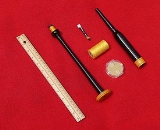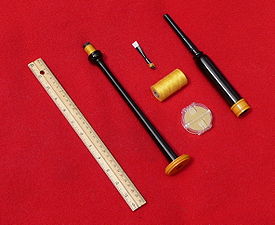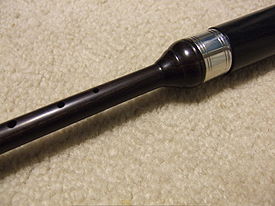
Practice chanter
Encyclopedia

Great Highland Bagpipe
The Great Highland Bagpipe is a type of bagpipe native to Scotland. It has achieved widespread recognition through its usage in the British military and in pipe bands throughout the world. It is closely related to the Great Irish Warpipes....
. In this respect, its purpose is twofold. First, it is the instrument used to learn how to play the Great Highland Bagpipes before taking up the bagpipes themselves. Secondly, as its name implies, the practice chanter can be used as a practice instrument for a more experienced player.
Design and construction
The practice chanter is essentially a long, thin piece of wood or plastic (in two parts) with a small-diameter hole bored lengthwise through the center. Air is directed into and through this bore hole and passes over a reedReed (instrument)
A reed is a thin strip of material which vibrates to produce a sound on a musical instrument. The reeds of most Woodwind instruments are made from Arundo donax or synthetic material; tuned reeds are made of metal or synthetics.-Single reeds:Single reeds are used on the mouthpieces of clarinets...
, the vibration of which causes the sound. On the lower portion of the chanter, holes are bored into the instrument at right angles to the central bore hole. These holes are then covered or uncovered to produce the melody
Melody
A melody , also tune, voice, or line, is a linear succession of musical tones which is perceived as a single entity...
.
Practice chanters come in various sizes and can be made out of various materials. They are made in both a short size which is designed for the smaller hands of a child and a regular size (as shown in the photo at right). The regular size is the traditional chanter length. There is a long or extended length version. The longer length chanters are long enough to accommodate a melody hole spacing identical to that of the bagpipe chanter itself. On some long chanters, the melody holes are also countersunk so that the outside face of the melody holes will have the same diameter as the bagpipe chanter holes.
The central bore hole can be straight or conical in shape. The conical variety will have a larger sound hole at the base.
Pipe Chanters and practice chanters are typically made out of a hard wood (such as African Blackwood), although before the expansion of the British Empire, native woods were used, as are still in many folk instruments. In the 1960s African Blackwood was in very short supply, and Ireland's only bagpipe maker, Andrew Warnock of The Pipers Cave in Northern Ireland, stumbled across a new alternative material, which, at the time was used for making police batons: an extremely strong and durable machinable acrylic composition known by several names - most machinists are familiar with it as Delrin while some call it Polypenco. Unaware that he was about to revolutionise the world of piping, Andrew began making chanters from the new dense material. The Gibson and Dunbar chanters are made out of polypenco plastic. It is a material that can be machined and polished much like soft metals. Since there is no danger of splitting with a plastic chanter, there is no need for a sole (see below), although some models retain it for decorative purposes.
The practice chanter can be played either sitting or standing.
Parts

The mouthpiece is the part into which the player blows. It can be made of nylon, wood, or plastic. The thicker portion of the top section (the reed cover) channels the air over the reed causing it to vibrate, which is what produces the sound. The ferrule is purely decorative. It can be made out of ivory, imitation ivory, plastic, nylon, or a metal such as silver.
The reed (shown just to the left of the top section at the top) can be made of cane or plastic. A plastic reed is shown in the photo. The two blades of the double reed vibrate against one another when air passes over them. This is what produces the sound which is then channeled down into and through the bottom section of the chanter which is shown just to the right of the ruler (provided for scale) in the photo.
The bottom section of the chanter is the portion which produces the melody. The melody results from the covering and uncovering of small holes drilled into the core of the chanter at precisely determined intervals. At the very top of this section is the stock into which the reed is inserted. The stock is wrapped with yellow hemp the function of which is to create a tight fit between the top and bottom sections of the practice chanter. This occurs as a result of the hemp absorbing moisture during play and swelling up. At the base of the bottom section is a yellowish ring called the sole. On a wooden chanter, such as that in the photo, the purpose of the sole is to keep the wood from splitting.
Reasons for use in place of bagpipes
The practice chanter is, as the name implies, often used to practice playing the bagpipesBagpipes
Bagpipes are a class of musical instrument, aerophones, using enclosed reeds fed from a constant reservoir of air in the form of a bag. Though the Scottish Great Highland Bagpipe and Irish uilleann pipes have the greatest international visibility, bagpipes of many different types come from...
. It has several advantages over the full bagpipe that led to this role. First, the practice chanter is significantly quieter and thus better suited for the indoors. Second, the practice chanter requires less blowing than the bagpipes
Bagpipes
Bagpipes are a class of musical instrument, aerophones, using enclosed reeds fed from a constant reservoir of air in the form of a bag. Though the Scottish Great Highland Bagpipe and Irish uilleann pipes have the greatest international visibility, bagpipes of many different types come from...
, making it physically easier to play. Finally, the practice chanter is easier to tune and maintain than the full bagpipe.

